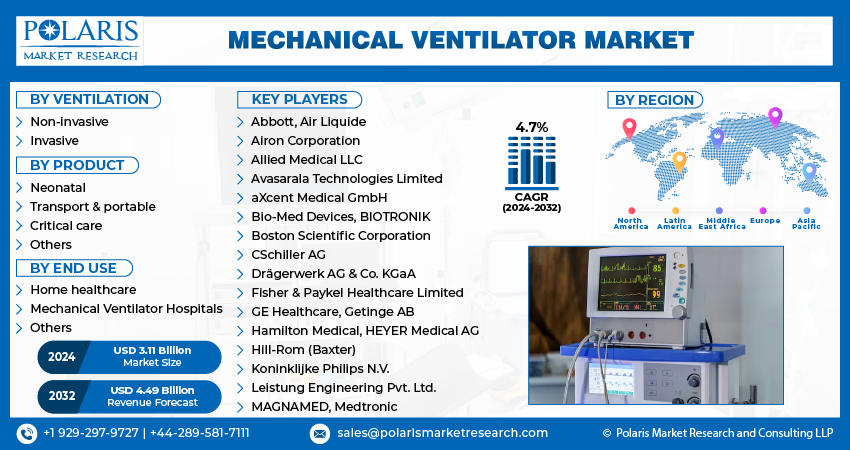The global mechanical ventilator market plays a critical role in supporting the lives of critically ill patients. This market, valued at USD 2.99 billion in 2023, is projected to reach USD 4.49 billion by 2032, exhibiting a steady CAGR of 4.7% during the forecast period.
Market Overview
Mechanical ventilators are life-saving devices that assist or control a patient’s breathing when they are unable to breathe adequately on their own. These devices deliver oxygen and remove carbon dioxide from the body, supporting vital respiratory functions.
Some of the major players operating in the global market include:
- Abbott
- Air Liquide
- Airon Corporation
- Allied Medical LLC (A Flexicare Company)
- Avasarala Technologies Limited
- aXcent Medical GmbH
- Bio-Med Devices
- BIOTRONIK
- Boston Scientific Corporation
- CSchiller AG
- Drägerwerk AG & Co. KGaA
- Fisher & Paykel Healthcare Limited
Key Market Drivers
- Rising Prevalence of Chronic Diseases: The increasing prevalence of chronic respiratory diseases such as chronic obstructive pulmonary disease (COPD), asthma, and sleep apnea is a major driver of market growth.
- Aging Population: The aging population is more susceptible to respiratory illnesses and complications, leading to increased demand for mechanical ventilation.
- Technological Advancements: Continuous advancements in ventilator technology, such as the development of smaller, more portable devices with advanced features, are driving market growth.
- Increased Surgical Procedures: The rising number of surgical procedures, particularly those involving anesthesia, increases the need for temporary respiratory support.
Growth Trends
- Focus on Patient Safety: There is a growing emphasis on patient safety, with the development of ventilators that minimize the risk of ventilator-associated lung injury (VILI).
- Advancements in Non-Invasive Ventilation: Non-invasive ventilation (NIV) techniques are gaining popularity due to their reduced risk of complications compared to invasive ventilation.
- Homecare Ventilation: The increasing adoption of homecare ventilation options allows patients to receive respiratory support in the comfort of their own homes.
- Data Analytics and Telemonitoring: The integration of data analytics and telemonitoring capabilities enables remote patient monitoring and improved clinical decision-making.
𝐒𝐞𝐠𝐦𝐞𝐧𝐭𝐚𝐥 𝐀𝐧𝐚𝐥𝐲𝐬𝐢𝐬:
Medical Ventilators Market, Ventilation Outlook (Revenue – USD Billion, 2019-2032)
- Non-invasive
- BiPAP
- CPAP
- Othera
- Invasive
Medical Ventilators Market, Product Outlook (Revenue – USD Billion, 2019-2032)
- Neonatal
- Accessories
- Ventilators
- Transport & portable
- Accessories
- Ventilators
- Critical care
- Ventilators
- Accessories
- Others
Medical Ventilators Market, End Use Outlook (Revenue – USD Billion, 2019-2032)
- Home healthcare
- Mechanical Ventilator Hospitals
- Others
The research study includes segmental analysis that divides the market into distinct groups or segments based on common characteristics. With market segmentation, businesses can identify specific customer groups that are more likely to be interested in specific products or services. Also, it enables these businesses to focus their marketing efforts and resources more efficiently, leading to higher conversion rates and improved return on investment. Furthermore, segmentation analysis helps companies develop personalized products or services, which can result in increased customer loyalty and improved customer satisfaction.
Recent Developments
- Getinge’s Servo-c Ventilator: The launch of Getinge’s Servo-c ventilator highlights the trend towards innovative and efficient solutions with features like modular components and intelligent fleet management.
- OES Medical’s Mains-Powered ICU Ventilator: This new ventilator addresses the critical need for reliable and efficient respiratory support in healthcare settings.
- CorVent Medical’s RESPOND-19 Ventilator: The CE Mark clearance for the RESPOND-19 ventilator demonstrates the ongoing development of advanced technologies to improve patient outcomes in critical care.
Challenges and Opportunities
- Stringent Regulatory Requirements: The medical device industry is subject to stringent regulatory requirements, which can increase the time and cost associated with product development and market entry.
- Competition: The market is competitive, with established players and new entrants vying for market share.
- Reimbursement Challenges: Securing adequate reimbursement for mechanical ventilators from insurance companies can be challenging.
Opportunities
- Development of Smart Ventilators: The development of smart ventilators with AI and machine learning capabilities offers significant opportunities for personalized and predictive respiratory support.
- Expansion into Emerging Markets: Expanding into emerging markets with growing healthcare needs presents significant growth potential.
- Collaboration with Healthcare Providers: Collaborating with healthcare providers to develop and market innovative solutions can enhance market penetration.
Conclusion
The mechanical ventilator market is poised for continued growth, driven by a combination of demographic, technological, and clinical factors. By embracing innovation, addressing the challenges, and capitalizing on the opportunities presented by this dynamic market, industry players can contribute to improving patient outcomes and enhancing the quality of life for individuals with respiratory conditions.
More Trending Latest Reports By Polaris Market Research:
Ultrasound Needle Guides Market
Complementary and Alternative Medicine for Anti-Aging & Longevity Market

